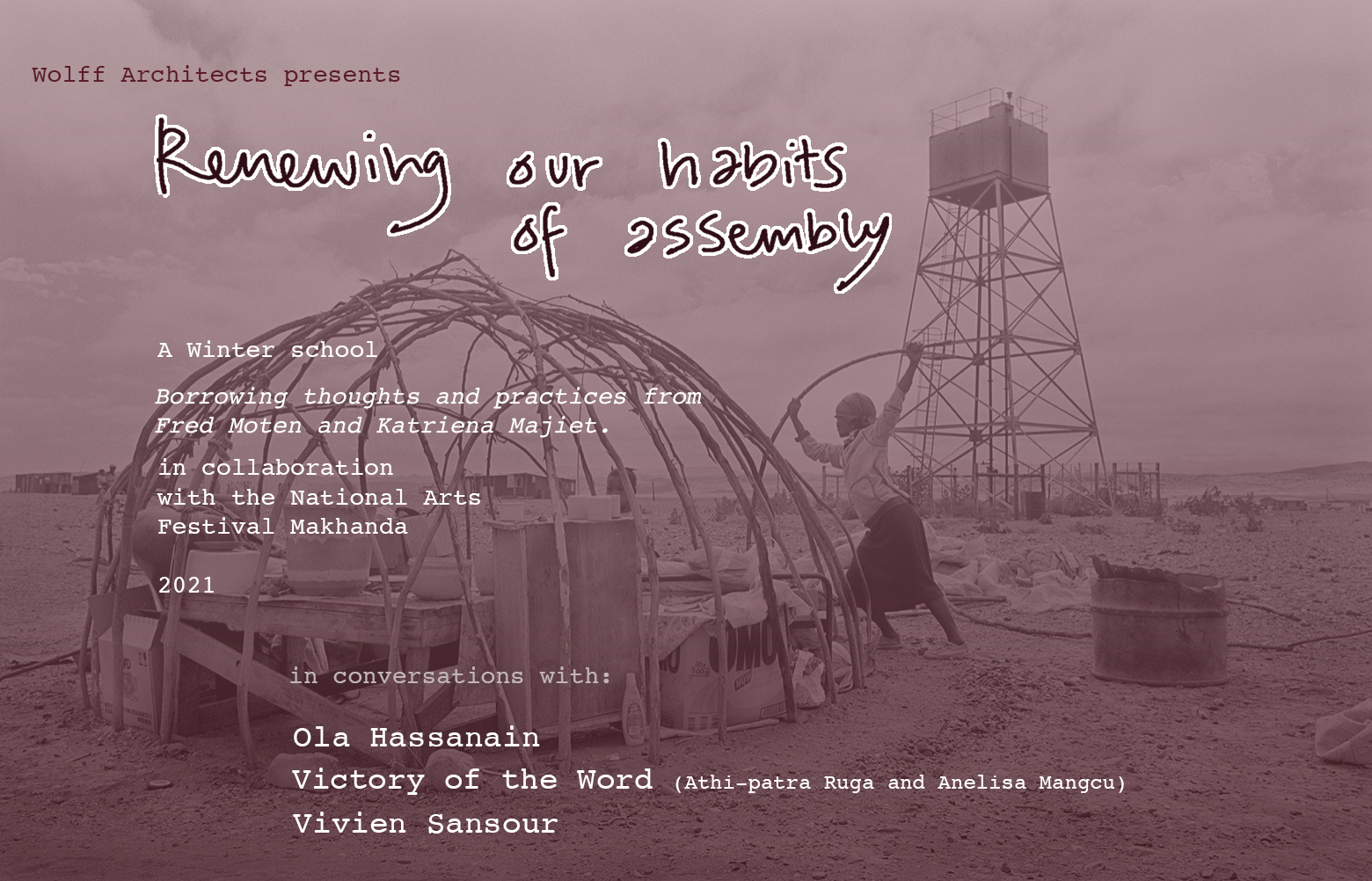‘Renewing our habits of assembly: borrowing thoughts and practices from Fred Moten and Katriena Majiet’
Wolff Architects presents a winter school with Ola Hassanain, Vivien Sansour and Victory of the Word, facilitated by the National Arts Festival, Makhanda.

The house that Katriena Majiet built in this photograph would be 30 years old this year. Paul Grendon captured her building this house, a rondehuis, in a place called Sanddrift, near Steinkopf in what is today known as the Northern Cape. We see in the image that she is building her house from materials gathered from around her and she uses her physical strength to bend the frames which would later be enshrouded with woven grass mats. The mats will cover and shield against harsh sun during the day and cold air at night. What we also see, are her belongings and a person (a family member?) already inside this construction-in-process. In other words, she is building around what she already has, with what she has gathered and, around what she has gathered. At traditional architecture schools we do not learn about this particular intelligence of building and if we do it is framed as a tradition of the past, rather than a practice of the present. When we learn to make buildings in architecture schools, the traditional curriculum demands that we conceive of the new building as a potential new and empty space, later to be filled with things accumulated over time. The idea of the tabula rasa, a so-called ‘clean slate’ dominates the standard curriculum. Empty sites, vacant lots and open land is assumed and often a prerequisite, there to fill with ‘new’, ‘innovative’ ideas, held together with walls that would divide up the service spaces from the served spaces, the public spaces from the private spaces and the living spaces from resting spaces. Clarity and order is equated with elegance and sophistication.
But what we see in this photograph is a demonstration of a particular habit of assembly, a knowledge of construction and a method of gathering that does not easily distinguish between what is gathered and who is gathering. There is no linear notion and distinction between when is the time to gather and when is the space ready of gathering. Instead, we see a construction of life where both happens simultaneously, alongside each other and with other things (the water tank for instance is captured linking with the construction of the rondehuis and not apart from it.) The simultaneity of all orders captured in the image is a design intelligence worthy of paying attention to if we are serious about building new freedoms, new worlds and new habits.
‘Like I said, I think for me, that’s what that poem is about, off what Manolo says. We have to renew our habits of assembly. We have to really practice getting together in that double sense of the word “practice”—you know, it’s a praxis, it’s a thing that we engage in constantly. But we also have to keep trying to get better at it. We have to renew it; we have to regenerate it. So, yeah, that’s it. It’s renewal of our habits of assembly; I don’t know, I feel like that should be pretty much our only object of study’
Fred Moten[1]
For the winter school we borrow from the poet Fred Moten (which he, in turn, borrows from Manolo Callahan) and extend the practice of Katriena Majiet in order for a renewed practice of space making. We propose ‘assembly’ in this case to mean both to gather as people and species; but also assembly as in ‘to put together’ the space for gathering. We imagine ourselves simultaneously as being assembled and that which is assembling. What are these habits then? How do we practice these habits of care, develop networks of collective freedoms and find sites of refusal and joy that exist amidst and often in spite of terrorism, predatory capital and colonial conquests? Can collective spatial practice renew and be renewed alongside these reflections?
[1] https://southjournal.org/fred-moten/ accessed June 2021